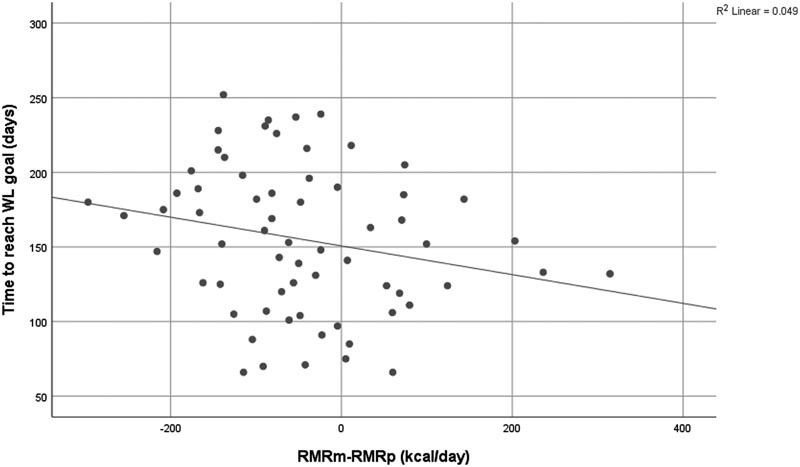Metabolic adaptation delays time to reach weight loss goals
The existence or absence and clinical relevance of metabolic adaptation in response to weight loss has been one of the most controversial topics in the field of obesity. A careful examination of the available literature suggests that differences between studies arise from inconsistencies related to the energy balance (EB) status and/or weight stability of participants when measurements are taken.
Aim
The objective of this study was to determine whether metabolic adaptation , at the level of resting metabolic rate, was associated with time to achieve weight loss goals, after adjusting for confounding factors.
Methods
A total of 65 overweight premenopausal women (BMI: 28.6 ± 1.5 kg/m2; age: 36.4 ± 5.9 years; 36 were white and 29 were black) followed an 800 kcal/d diet to a BMI ≤ 25 kg/m2.
Body weight and composition were measured at baseline and after weight loss.
Diet adherence was calculated from total energy expenditure, determined by doubly labeled water, and changes in body composition.
Metabolic adaptation was defined as a measured resting metabolic rate significantly lower than predicted (from the regression model itself).
A regression model was developed to predict the time needed to achieve weight loss goals, including target weight loss, energy deficit, diet adherence, and metabolic adaptation as predictors.
Results
Participants lost an average of 12.5 ± 3.1 kg (16.1% ± 3.4%) over 155.1 ± 49.2 days. The average dietary adherence was 63.6% ± 31.0%.
There was significant metabolic adaptation after weight loss (−46 ± 113 kcal/d, p = 0.002) and this variable was a significant predictor of time to achieve weight loss goals (β = −0.1, p = 0.041), even after adjusting for confounding factors (adjusted R2 = 0.63, p < 0.001).

Simple correlation between metabolic adaptation to the level of RMR (RMRm-RMRp) and the time to reach the WL goal (days). The greater the metabolic adaptation, the longer the time needed to reach the WL goal. RMR, resting metabolic rate; RMRm, measured RMR; RMRp, predicted RMR; WL, weight loss
Conclusion
In overweight premenopausal women, metabolic adaptation after a 16% weight loss increases the time needed to achieve weight loss goals.
Discussion
The present findings represent the first study to examine whether metabolic adaptation was associated with time to achieving weight loss goals.
We found that the greater the metabolic adaptation after weight loss, the longer the time needed to reach weight loss goals (BMI = 25 kg/m2), even after adjusting for target weight loss, energy and diet adherence, suggesting strategies to decrease metabolic adaptation and increase diet adherence can accelerate weight loss.
In conclusion, in overweight premenopausal women, metabolic adaptation after a 16% weight loss increases the time needed to achieve weight loss goals. Additional research should confirm these findings in a population of men and women with obesity.
Importance of the study What is already known
What does this study add?
How might these results change the focus of clinical practice?
|
Comments
Metabolic adaptation increases time to achieve weight loss goals for premenopausal women
After a 16% weight loss, overweight premenopausal women experienced metabolic adaptation associated with a longer-than-expected time to achieve weight loss goals, according to study results published in Obesity.
"Regardless of the extent of metabolic adaptation, its clinical relevance has not yet been fully determined," Catia Martins, MSc, PhD, professor in the department of clinical and molecular medicine and faculty of medicine and health sciences in the research group of obesity at St. Olav’s University Hospital in Trondheim, Norway, and the department of nutritional sciences at the University of Alabama at Birmingham, and colleagues, they wrote. "It was initially suggested that metabolic adaptation could be a possible explanatory mechanism for long-term weight regain (relapse), as well as resistance to weight loss."
Researchers evaluated 65 overweight premenopausal women (mean age, 36.4 years) with an average BMI of 28.6 kg/m 2 who followed an 800 kcal per day diet until their BMI reached 25 kg/m 2 or less. Body weight and composition were measured before and after weight loss, and diet adherence was calculated through total energy expenditure determined by doubly labeled water and composition changes.
Metabolic adaptation was defined as a measured resting metabolic rate significantly lower than predicted.
Participants experienced an average 16.1% (12.5 kg) reduction in body weight over 155.1 days. Adherence to the diet, on average, was 63.6%.
After weight loss, measured resting metabolic rate (mean, 1305 kcal per day) was lower than predicted (1351 kcal per day; P = 0.002).
This metabolic adaptation predicted the time needed to reach the weight loss goal ( p = 0.041) and was maintained after adjusting for confounders ( p < 0.001).
There were no significant associations between metabolic adaptation and target weight loss, energy deficit, or diet adherence. There was also no significant association between metabolic adaptation and rate of weight loss or the difference between observed and predicted rate of weight loss.
“It should be emphasized that this metabolic adaptation was observed after 4 weeks of weight stabilization following the active phase of weight loss and, as such, is probably much less than would be expected during the active phase of weight loss. ...It is reasonable to expect that metabolic adaptation during active weight loss in the present study would have been closer to 110 kcal per day (46 × 2.42) than to 46 kcal per day,” the researchers wrote.
“Further research should confirm these findings in a population of men and women with obesity,” the researchers wrote.
















